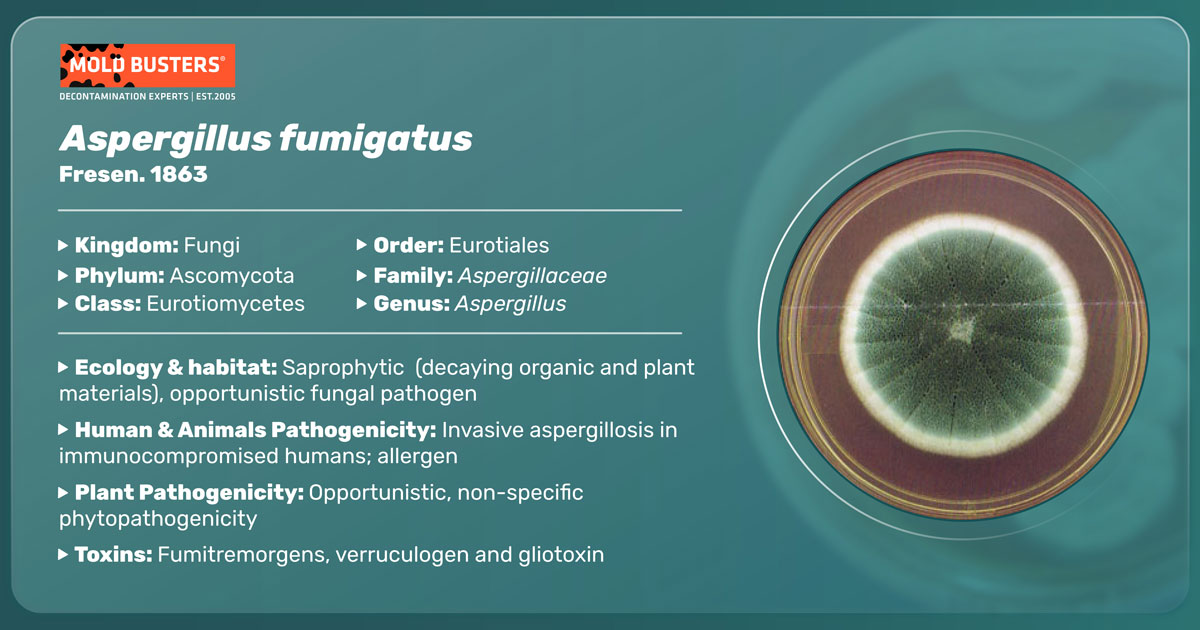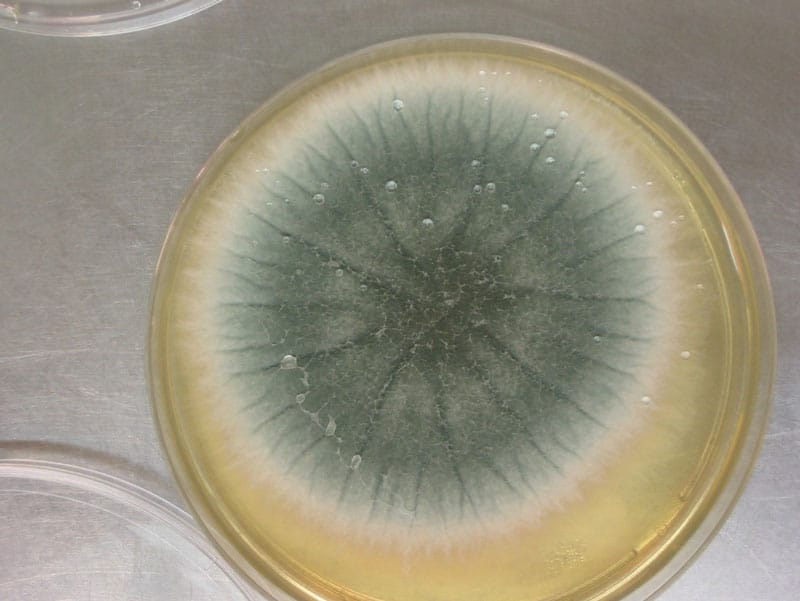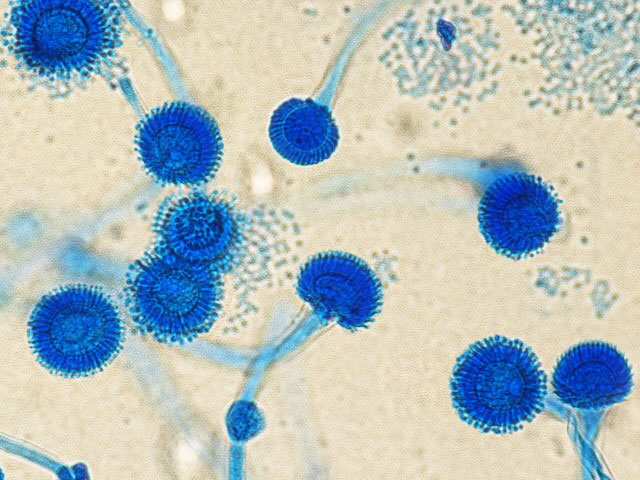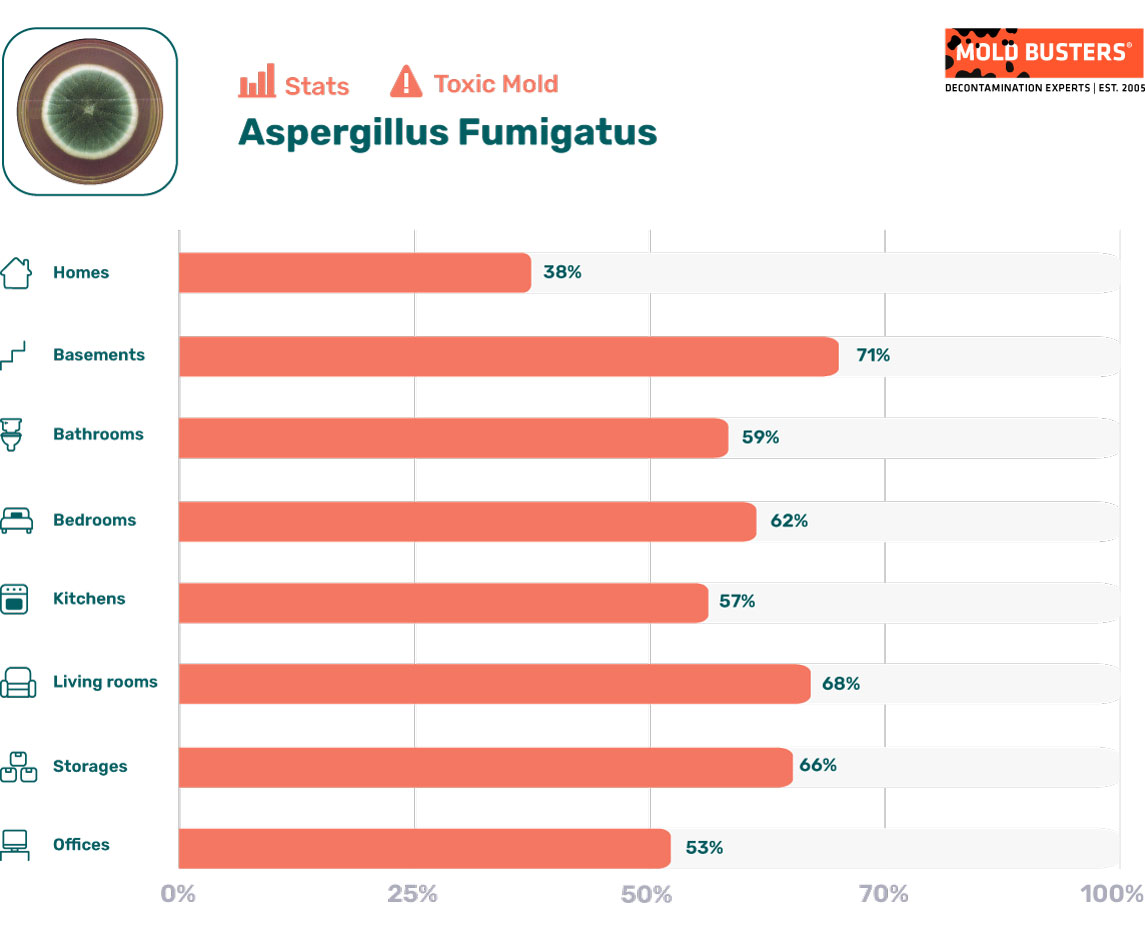Fresen. 1863
What is Aspergillus fumigatus?
Aspergillus fumigatus is a saprotrophic fungus with a cosmopolitan distribution. In nature, it can typically be found in soil and decomposing organic material, such as compost heaps. It plays an essential role in carbon and nitrogen recycling, and without it, many natural cycles would be non-existent. A. fumigatus is a known opportunistic human pathogen and represents the most frequent cause of invasive fungal infection (aspergillosis) in immunocompromised individuals. Produces mycotoxins fumitremorgen, verruculogen, and gliotoxin [1–3].

Areas where Aspergillus fumigatus mold thrive?
Aspergillus fumigatus mold grows well both indoors and outdoors. Generally, it thrives in warm temperatures, with optimal growth at 40-42°C (107–111°F). Its minimum growing temperature resides at 12°C (53°F) [3], with the maximum near 55°C (131°F) [2].
Aspergillus fumigatus requires moderate levels of moisture for growth. It needs the water activity of growing media to be around 0.82 aw at 40°C. It can be found in soil, decomposing both plant and animal matter. It commonly colonizes seeds, especially cereal grains, and often contaminates stored commodities. A. fumigatus can also grow on cured and processed meats, especially in the tropics [3].
Indoors, it can be found in dust, ventilation ducts, and potted plants. It can also develop on floors and walls, especially in bathrooms, kitchens, and other warm and moist environments.
Aspergillus fumigatus morphology
A. fumigatus colonies are low, blueish-green, and broadly spreading, with a velvety texture (Fig. 1). Conidiophores (asexual spore-bearing structures) are formed from the surface hyphae, going from 200–400 µm in length. Conidia spherical to subspheroidal, 2.5–3.0 µm in diameter, with finely roughened or spinose walls, forming radiate heads at first, then well-defined columns of conidia (Fig. 2).


What food is Aspergillus fumigatus mold found in?
Improper grain and food storage, especially in a humid environment, can lead to A. fumigatus mold developing. It often occurs on starchy foods such as bread, rice, and cereals. Ingestion of such contaminated commodities exposes individuals to mycotoxins and pathogen spores.
Aspergillus fumigatus mold statistics
As part of the data analysis presented inside our mold statistics resource page, we have calculated how often mold spore types appear in different parts of the indoor environment when mold levels are elevated. Below are the stats for Aspergillus fumigatus:


What are the diseases caused by Aspergillus fumigatus?
Aspergillus fumigatus mold causes a wide range of human diseases collectively referred to as aspergillosis. The most commonly affected organs are those of the respiratory system, with lung disease being the most serious of them all. Some common forms of aspergilli infections are:
- Pulmonary aspergillosis: This is a fungal infection of the lungs. It can be a short-term illness or a chronic illness.
- Aspergilloma or “fungal ball”: Another type of lung infection that leads to the formation of a ball of fungus in the lungs.
- Skin and nail infections
- Ear and eye infections
- Invasive aspergillosis: this is a very serious condition in which the fungal infection gets into the bloodstream, and is dispersed to various tissues and organs, leading to loss of function.
- Allergic conditions: this includes allergic sinusitis and allergic bronchopulmonary aspergillosis.
Is Aspergillosis an opportunistic infection?
Aspergillus fumigatus infections do not easily develop in a normal, healthy individual. Aspergillosis mostly affects people with underlying conditions (such as hematological malignities, or HIV/AIDS), or who have compromised immunity due to some sort of immunosuppressive therapy, such as corticosteroids. Additionally, people with diseases such as asthma, cystic fibrosis, or tuberculosis are also susceptible to aspergillosis [4,5].
Lung infections with Aspergillus fumigatus
Pulmonary aspergillosis begins by inhalation of Aspergillus spores. Their small size (2-3μm) allows them to reach all compartments of the lungs, including the alveoli. Spores are lodged in lung tissue and initiate infection. For most people, the infection is often cleared by innate immune responses.
In immunocompromised individuals, the immune system fails to deal with the threat. Innate immune cells such as neutrophils and macrophages fail to detect spores that germinate readily in a warm, moist, and nutrient-rich environment, such are the alveolus in human lungs. According to the CDC, over 6 million people live with some form of aspergillosis [4], and the figure is thought to be much higher as there are many undiagnosed or misdiagnosed cases.
What are the symptoms of mold in your lungs?
The most common symptom of pulmonary aspergillosis is coughing. This is non-specific and mimics several other lung diseases. However, the cough is often bloody. Infected individuals may also experience chest pains, difficulty in breathing, and may also develop a fever. In most cases, these symptoms often arise in addition to an already existing lung disease such as tuberculosis, cystic fibrosis, or asthma, thus making it difficult to diagnose. When the disease progresses to a chronic state, individuals may start losing weight and experiencing general body malaise.
What are allergies caused by Aspergillus fumigatus?
Fungal spores are known to play a role in the onset and progression of allergies, so similar to other molds, Aspergillus fumigatus spores are allergens. [5].
Fungal allergies can be classified into two main groups: those affecting the upper airways, i.e., allergic sinusitis (which often causes flu-like symptoms), and those affecting the lower respiratory tract (which causes more serious symptoms). Allergic sinusitis usually causes a runny nose, reduced sense of smell, and possibly a headache. It is more of an irritation, and not a significant medical condition.
Allergic bronchopulmonary aspergillosis (ABS) is a serious condition, especially when it occurs in asthmatics. ABS is estimated to be present in 2.5% of asthma patients. This translates to 4.8 million people worldwide [4]. It is manifested with serious symptoms: a cough with brown-colored sputum, wheezing, shortness of breath, chest pain, and fever.
What are invasive Aspergillosis symptoms?
Invasive aspergillosis is the most serious form, and it is very rare. The CDC reports only 1 or 2 cases per 100,000 people annually. It is exclusively a disease of the immunocompromised, and never affects healthy individuals. It occurs when the fungal infection is not treated in time, so the infection gets into the bloodstream and is disseminated throughout the body, infecting major organs such as the heart and kidneys. It presents as fever and chills, with symptoms of shock. In the lungs, it causes chest pains, bloody coughs, and internal bleeding. It may also cause kidney and liver failure. At this level, the infection is life-threatening.
How to treat Aspergillus fumigatus?
Most forms of aspergillosis are not complicated to treat. These molds are sensitive to most antifungal agents, and infected individuals usually respond well to therapy. Itraconazole is usually the mainstay of antifungal therapy. Amphotericin B is used in cases of serious infection or resistance to other medications. In most cases, these drugs successfully eliminate the infection.
How do you get rid of Aspergillus fumigatus?
Preventing the mold from developing in your home is (as always) cheaper and easier to do than to remove it. For A. fumigatus, this involves decontamination (using several chemical products) of all surfaces where it has developed. However, the course of action against A. fumigatus mold is to contact a certified mold removal company that will inspect your home for mold and deal with any growths if they are present. Call Mold Busters today to book an appointment.
References
- Rhodes JC (2006). Aspergillus fumigatus: growth and virulence. Med Mycol. 44 Suppl 1:S77-81
- Latgé JP (1999). Aspergillus fumigatus and aspergillosis. Clin Microbiol Rev. 12(2):310-50.
- Pitt JI, Hocking AD (2009). Aspergillus and Related Teleomorphs. In: Fungi and Food Spoilage. Springer, Boston, MA, pp 469
- CDC (2019). Retrieved from website.
- Denning DW, Pashley C, Hartl D, Wardlaw A, godet C, Del Giaco S, Delhaes L, Sergejeva S (2014). Fungal allergy in asthma-state of the art and research needs. Clin Transl Allergy. 4:14.

Get Special Gift: Industry-Standard Mold Removal Guidelines
Download the industry-standard guidelines that Mold Busters use in their own mold removal services, including news, tips and special offers:

Written by:
John Ward
Account Executive
Mold Busters
Edited by:
Dusan Sadikovic
Mycologist – MSc, PhD
Mold Busters
